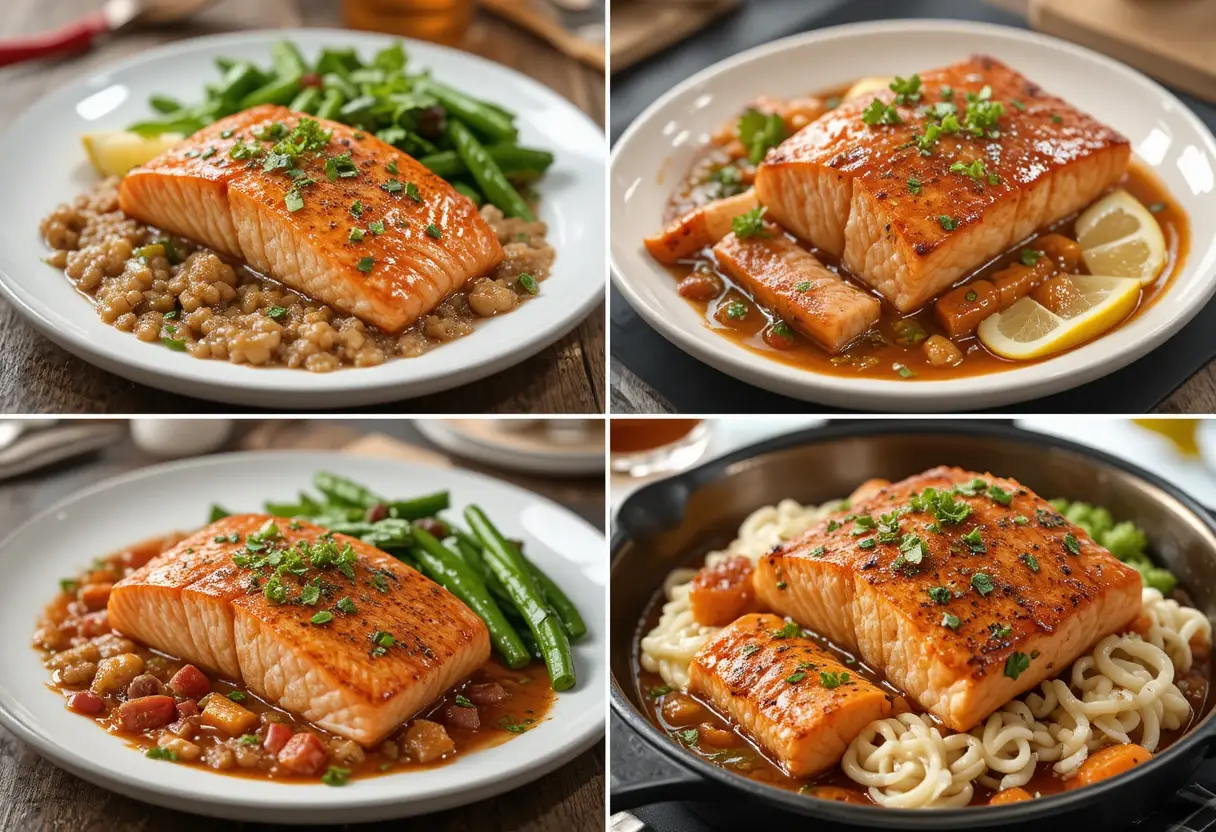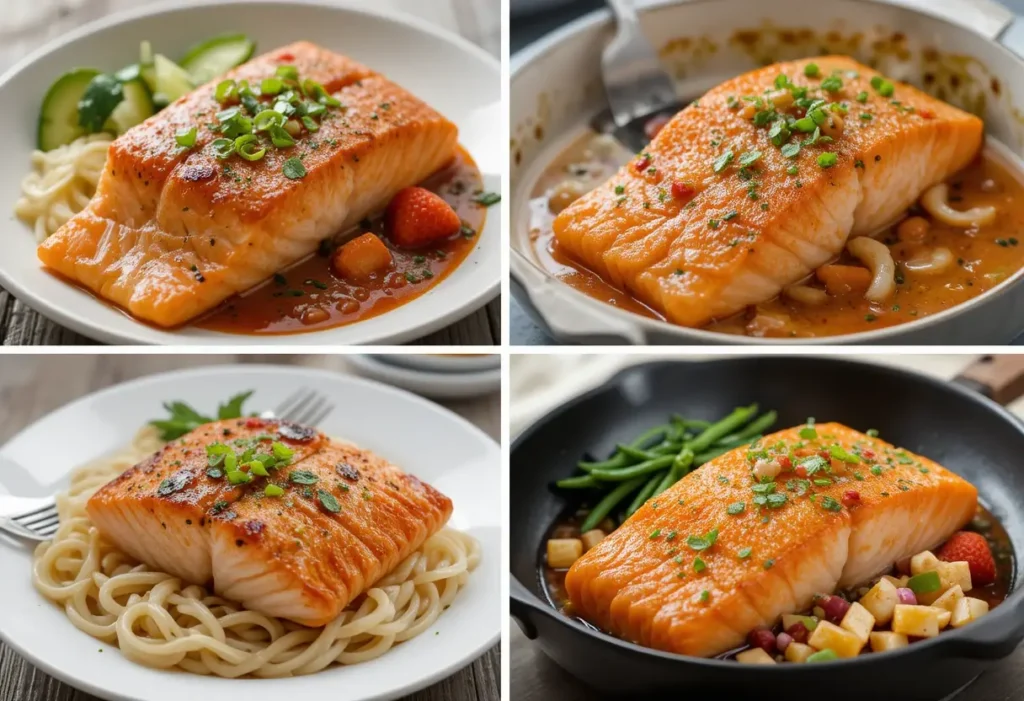Salmon is a culinary treasure cherished worldwide for its rich flavor, impressive nutritional benefits, and versatility in the kitchen. When it comes to preparation, the most popular ways to cook salmon is grilling. The smoky char, ease of preparation, and ability to preserve salmon’s natural flavors make grilling a top choice for chefs and home cooks alike. That said, other methods like baking, pan-searing, and poaching also offer delicious alternatives, each catering to personal preferences and dietary needs.
The Nutritional Benefits of Salmon
Salmon is a nutritional powerhouse, making it a staple in health-conscious diets. Packed with omega-3 fatty acids, it supports heart health, reduces inflammation, and promotes brain function. Additionally, it is an excellent source of high-quality protein, which is essential for muscle repair and growth. Rich in vitamins D, B12, and selenium, salmon contributes to bone health, energy production, and immune system support. Its nutrient profile not only makes it delicious but also a highly beneficial addition to a balanced diet.
Table of Contents
Why Salmon is a Culinary Favorite
Salmon has earned its place in kitchens worldwide for several compelling reasons. Its adaptability to various cooking techniques, distinctive yet mild flavor, and health benefits make it a go-to choice for meals ranging from quick weeknight dinners to elegant celebrations.
Flavor Profile: Mild and Versatile
Salmon’s flavor profile is one of its greatest assets. Its natural richness pairs beautifully with a wide range of seasonings and sauces, from zesty citrus and herbs to bold soy-based marinades. The mildness of its taste allows it to shine in diverse cuisines, including Asian, Mediterranean, and American. This versatility ensures that it caters to a broad spectrum of palates.
Sustainability and Sourcing of Salmon
As awareness about sustainable food practices grows, the sourcing of salmon has become a significant factor in its popularity. Responsible fisheries and aquaculture practices ensure a steady supply of salmon while protecting marine ecosystems. Consumers are increasingly choosing sustainably sourced salmon, appreciating the balance between environmental responsibility and access to high-quality seafood.
Whether grilled, baked, or poached, salmon continues to captivate taste buds and contribute to healthy living. Its combination of versatility, nutrition, and sustainability ensures that it remains a top choice for meals around the world.
Common Methods for Cooking Salmon
Salmon’s versatility allows it to be prepared using various cooking methods, each offering unique textures and flavors. Here are some of the most common techniques for cooking salmon:
Grilling Salmon
Grilling salmon is one of the most popular ways to prepare it. The high heat caramelizes the natural fats, creating a smoky, charred exterior while maintaining a tender and juicy interior. This method is ideal for fillets or steaks and works well with marinades or dry rubs. Grilling imparts a bold flavor that pairs perfectly with summer vegetables or a zesty citrus glaze.
Baking Salmon
Baking is a foolproof and straightforward method that suits beginners and experienced cooks alike. By cooking salmon in the oven, the fish retains its moisture and develops a delicate, flaky texture. Baking allows for creative experimentation with seasonings, from garlic and herbs to soy sauce and honey. For an even juicier outcome, try baking salmon in foil packets with vegetables and lemon slices.
Pan-Seared Salmon
Pan-searing creates a crispy, golden crust while preserving the tender flesh inside. This quick method is perfect for those who love a combination of textures in their salmon. Using a hot skillet with a touch of oil or butter, the fish develops a beautiful sear. Adding a splash of wine or broth during cooking can create a simple and flavorful pan sauce to accompany the dish.
Poached Salmon
Poaching involves gently simmering salmon in liquid, such as water, broth, or white wine, which keeps it incredibly moist and tender. This method is excellent for highlighting the fish’s natural flavor and works well with light seasoning, like dill, bay leaves, and lemon. Poached salmon is perfect for salads, cold preparations, or pairing with a creamy dill sauce.
Sous Vide: A Modern Technique
Sous vide cooking involves vacuum-sealing salmon and cooking it in a precisely controlled water bath. This method guarantees even cooking and allows the fish to retain its natural juices and flavors. Sous vide is ideal for achieving a perfectly tender and buttery texture, and it pairs wonderfully with a quick sear or sauce for finishing.
How to Choose the Right Method for Cooking Salmon
With so many ways to prepare salmon, the choice often depends on personal preferences, available time, and the accompanying ingredients. Here are some factors to consider:
Considering Texture Preferences
- Grilling and pan-searing create a crispy exterior for those who love a bit of crunch.
- Baking and poaching result in a softer, flakier texture, appealing to those who prefer moist and delicate salmon.
- Sous vide offers unparalleled tenderness, ideal for fans of a buttery, melt-in-your-mouth experience.
Time and Effort Required
- Grilling and pan-searing are quick methods that deliver bold flavors but may require more attention during cooking.
- Baking is perfect for hands-off preparation, making it convenient for busy weeknights.
- Poaching and sous vide take a bit longer but reward patience with consistently moist and flavorful results.
Complementary Flavors and Ingredients
- Grilled salmon pairs well with smoky flavors and robust marinades.
- Baked salmon shines with fresh herbs, citrus, or vegetables.
- Pan-seared salmon is enhanced by rich sauces or simple butter and garlic.
- Poached salmon matches light, tangy accompaniments like lemon-dill sauce.
- Sous vide salmon can be elevated with a quick sear and gourmet toppings, such as truffle oil or microgreens.
By considering texture preferences, time constraints, and complementary flavors, you can choose the perfect method to enjoy salmon’s delightful taste and versatility.
Step-by-Step Guide to Baking Salmon (The Most Popular Method)
Baking salmon is a popular and foolproof method that ensures a moist, flavorful dish every time. Here’s how to do it perfectly:
Ingredients Needed
- Fresh salmon fillets or steaks
- Olive oil or melted butter
- Salt and pepper
- Lemon slices
- Optional: fresh herbs (dill, parsley, thyme), garlic, spices, or marinades
Preparing the Salmon: Tips and Tricks
- Choose Fresh Salmon: Opt for high-quality salmon with a vibrant color and minimal odor. Wild-caught varieties often have a richer flavor.
- Debone the Fillet: Run your fingers over the flesh to check for pin bones and remove them with tweezers.
- Pat Dry: Use paper towels to pat the salmon dry; this helps seasonings stick better and promotes even cooking.
- Season Generously: Drizzle olive oil or butter over the salmon and sprinkle with salt, pepper, and your choice of herbs or spices.
Oven Temperature and Timing
- Preheat the Oven: Set the oven to 375°F (190°C) for evenly cooked, moist salmon.
- Prepare the Baking Tray: Line a baking sheet with parchment paper or foil for easy cleanup.
- Bake the Salmon: Place the seasoned salmon on the prepared tray, skin-side down. Bake for 12-15 minutes, depending on the thickness of the fillet (about 10 minutes per inch of thickness).
- Check for Doneness: Salmon is ready when it flakes easily with a fork and reaches an internal temperature of 145°F (63°C).
Variations: Spices, Herbs, and Marinades
- Classic Lemon and Herb: Add lemon slices, garlic, and dill for a refreshing flavor.
- Asian-Style Glaze: Use soy sauce, honey, ginger, and sesame seeds for a sweet-savory kick.
- Spicy Cajun: Sprinkle Cajun seasoning and paprika for bold heat.
- Mediterranean: Top with olives, cherry tomatoes, and feta cheese for a Mediterranean twist.
Healthiest Ways to Cook Salmon
Low-Oil Methods
- Poaching: Cook salmon gently in water or broth for a moist texture without added fats.
- Steaming: Use a steamer basket to preserve salmon’s natural oils and avoid extra calories.
- Baking: Skip heavy oils and use parchment paper to keep the fish tender and flavorful.
Retaining Nutritional Value
- Avoid cooking salmon at excessively high temperatures to preserve its omega-3 fatty acids.
- Use minimal processing to maintain its protein content and essential vitamins.
- Pair salmon with nutrient-rich sides like leafy greens or quinoa for a balanced meal.
Mistakes to Avoid When Cooking Salmon
Overcooking
- Salmon is best when cooked just until it flakes easily. Overcooking can result in a dry and rubbery texture.
- Use a thermometer to monitor the internal temperature and avoid guesswork.
Choosing the Wrong Salmon Cut
- Fillets are great for grilling, baking, and pan-searing, while steaks work well for grilling or poaching.
- Avoid thin cuts if you prefer moist, flaky salmon, as they cook faster and can dry out easily.
Inadequate Seasoning
- Salmon’s natural flavor is mild, so it benefits from bold seasonings or marinades.
- Don’t forget to season the skin side if you plan to eat it, as it can add a delightful crunch.
By mastering these techniques and avoiding common pitfalls, you can enjoy perfectly cooked salmon that’s both delicious and healthy!
FAQs about the Most Popular Ways to Cook Salmon
What is the easiest way to cook salmon for beginners?
The easiest method for beginners is baking. Preheat the oven to 375°F (190°C), season the salmon with salt, pepper, and your choice of herbs, and bake on a lined baking sheet for about 12-15 minutes. Baking requires minimal supervision and delivers consistently moist and flavorful results.
How do I know when my salmon is done?
Salmon is done when:
It flakes easily with a fork.
The flesh changes from translucent to opaque.
The internal temperature reaches 145°F (63°C) when measured with a food thermometer. Avoid overcooking by checking the fish a few minutes before the estimated cooking time is up.
Can I cook salmon from frozen?
Yes, you can cook salmon directly from frozen. For best results:
Rinse the frozen fillets under cold water to remove ice crystals.
Bake in the oven at 400°F (200°C) for 25-30 minutes, seasoning halfway through.
Alternatively, pan-sear the frozen salmon on low heat, then cover and cook until done. Cooking from frozen takes slightly longer but is safe and convenient.
Should I remove the skin before cooking salmon?
It depends on your cooking method and preference:
Keep the skin on: It helps protect the fish from drying out and creates a crispy texture when grilling or pan searing.
Remove the skin: If you prefer skinless salmon, peel it off after cooking when the fish is tender and the skin easily separates. For poaching or baking, leaving the skin on is optional as it doesn’t crisp in these methods.
What side dishes pair best with salmon?
Salmon pairs well with a variety of sides, including:
Vegetables: Roasted asparagus, steamed broccoli, or a fresh salad.
Grains: Quinoa, rice pilaf, or couscous.
Potatoes: Mashed, roasted, or baked sweet potatoes.
Sauces and Toppings: Dill yogurt sauce, lemon butter, or mango salsa. The key is balancing the rich, buttery salmon with light, fresh, or mildly seasoned sides.
How do I store leftover cooked salmon?
To store leftover salmon:
Allow it to cool to room temperature.
Wrap it tightly in aluminum foil or plastic wrap, or place it in an airtight container.
Refrigerate for up to 3 days. For longer storage, freeze the salmon in a sealed freezer safe container for up to 2 months. Reheat gently to avoid drying out the fish.
Conclusion
Baking salmon is a simple yet versatile cooking method that consistently delivers moist and flavorful results, making it perfect for both beginners and seasoned cooks. Whether you’re trying classic recipes or experimenting with variations, baked salmon can suit a variety of tastes and occasions. For inspiration, check out a Mediterranean Salmon Recipe to experience rich, herb-infused flavors or explore pairing options in Top 5 Salmon Spinach Recipes for healthy, complementary sides. If you’re in the mood for something different, try these Canned Salmon Burgers for a creative take on salmon. By mastering these techniques and exploring new ideas, you can create delicious, wholesome meals that everyone will enjoy.



